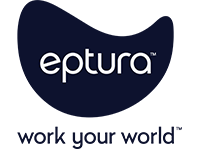
Planning a meeting used to mean chasing down calendars, claiming an open room, and crossing fingers that the screen share would actually work. These days, it’s more complex. Balancing remote and in-office schedules, dodging double bookings, and avoiding another “this could’ve been an email” moment.
Key takeaways
- Smart meeting scheduling tools reduce wasted time. AI-powered platforms help eliminate unnecessary meetings, right-size durations, and suggest ideal attendees based on real work patterns.
- The right room makes all the difference. Being matched with the best-fit space, equipment, and layout means your team walks into rooms that are ready for action, not frustration.
- Hybrid meetings should feel seamless. With the integration between Eptura Engage and Microsoft Teams, remote and in-office participants stay fully connected.
Meetings still matter. When structured well, they create alignment, drive decisions, and keep momentum moving. The problem isn’t meeting fatigue. It’s friction in the process. According to Eptura’s 2025 Workplace Index, a staggering 67% of companies are using between 6 to 40 different workplace technology solutions, leading to fragmented data and disjointed employee experiences.
Modern meeting scheduling tools help reduce that friction. By using real-time data, smart integrations, and behavior-based insights, these systems streamline the planning process and support more effective collaboration.
6 best practices for scheduling successful hybrid meetings
-
Consider canceling meetings you don’t need
A crucial part of learning how to organize a meeting is knowing when not to have one. If a decision can be made quickly or a status update can happen in a shared document, consider skipping the meeting altogether.
Scheduling platforms can identify low-impact, recurring meetings and suggest more efficient alternatives. This helps teams cut back on unnecessary syncs and focus time where it matters most.
Action step: Use meeting analytics to review recurring invites. Cancel or reformat sessions that no longer serve a clear purpose.
-
Invite with intention
When planning how to organize a meeting, it’s easy to over-invite “just in case.” But too many attendees can dilute focus and stall decision-making.
Smart scheduling tools analyze roles, when participants are already planning to be in the office, and past participation to suggest only the most relevant participants. You can also loop in optional attendees with summaries instead of them sitting through the full meeting.
Action step: Review your attendee list before sending an invite. Mark optional attendees and enable follow-up notes or recordings.
-
Set a time that fits the task
Many meetings default to 30 or 60 minutes out of habit, not necessity. But optimizing duration is an underrated part of how to organize a meeting effectively.
Data-driven scheduling tools recommend time blocks based on actual meeting patterns. A check-in might only need 20 minutes. A planning session may work better in 45.
Action step: Let your scheduling tool suggest time slots based on meeting type and past behavior — and adjust default durations to match.
-
Choose rooms that match the meeting purpose
The space you meet in should support the kind of meeting you’re having. A client pitch might call for a polished boardroom, while a creative session might work better with open seating and whiteboards. With 34% of businesses planning to increase in-office days in 2025 (Eptura), the pressure to optimize physical spaces is mounting.
Meeting room booking software can tie meeting details to room capabilities and help teams reserve the right space for the job — accounting for group size, tech requirements, amenities like catering, and even small things like whether the room has working markers. That way, time gets spent on the meeting — not on setup or troubleshooting.
Action step: Add agenda details or meeting type into the scheduling tool to get matched with rooms that support your needs.
-
Make hybrid feel seamless
Understanding how to organize a meeting now means thinking about both in-person and remote participants. Hybrid work solutions are the norm, not the exception. In fact, desk bookings have grown 33% year-over-year, according to Eptura’s research, confirming that a flexible, hybrid approach is here to stay.
Integrated platforms that sync calendars, meeting links, and in-office schedules help teams coordinate without added manual effort. Features like time zone alignment, file sharing, and auto-generated links keep everyone aligned from anywhere.
Action step: Utilize tools that automatically incorporate video links, accommodate time zone differences, and facilitate asynchronous follow-up.
-
Let the system handle the overhead
Behind every well-run meeting is a string of micro-decisions like room selection, attendee coordination, time adjustments. Scheduling tools that track patterns and preferences help automate those tasks. This is becoming critical, as 77% of facility managers plan to adopt AI to enhance the employee experience (Eptura, 2025).
They suggest alternatives like using a smaller room, trimming a meeting that usually ends early, or reserving shared space when your team is in the office.
Action step: Review your scheduling platform’s suggestions weekly to continuously improve how you plan and manage meetings.
Integrate workspace booking with tools employees already use
The tools people use every day should support how they meet. With integrated scheduling between Eptura Engage and Microsoft Teams, teams can handle key tasks — like booking desks and rooms, syncing reservations to Outlook, and checking coworkers’ in-office schedules — without switching platforms. They can also use Eptura copilot to automate workspace booking based on their existing preferences and past behavior with natural language requests directly in Microsoft Teams.
Keeping everything in one familiar place helps reduce friction and lowers the need for extra training or new workflows.
Smarter scheduling starts behind the scenes
Meetings still matter, but only when they’re planned with purpose. With support from the right systems, teams can streamline scheduling, reduce distractions, and focus on what the meeting is meant to accomplish.
Clear agendas, reliable tech, and the right space make it easier for people to show up prepared and stay engaged. It’s not about adding more tools; it’s about making the ones already in use work better together.









